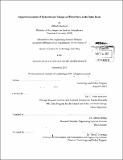Impact assessment of hydroclimatic change on water stress in the Indus Basin
Author(s)
Rasheed, Bilhuda
DownloadFull printable version (21.64Mb)
Alternative title
Impact assessment of hydroclimatic change in the Indus Basin
Other Contributors
Massachusetts Institute of Technology. Technology and Policy Program.
Advisor
C. Adam Schlosser.
Terms of use
Metadata
Show full item recordAbstract
Ninety percent of Pakistan's agricultural output is produced in fields irrigated by the Indus basin irrigation system, the world's largest network of canals, dams, barrages and tubewells. River flows, primarily fed by snow and glacial melt, are highly seasonal and fluctuate between intense floods and droughts. Built storage is relatively small, with withdrawals averaging at 70% of annual availability. Climate change, growth in sectoral water demands, and changes in water management infrastructure could have a profound impact on water stress in the coming decades. The interplay and contribution of these influences is explored using a model of the managed Indus River basin. To account for key hydro-climate shifts, I translate temperature rise and glacier cover scenarios into river runoff in 2050. I also project sectoral water demands to 2050. I then use an optimization model to estimate dam releases and project water stress to 2050. I find that climate change will cause decreases in peak river flows, but the changes in runoff will be comparable to current interannual variability. The most significant increase in water stress is caused by a scenario of 1-2.5°C warming and 1% annual glacial retreat. However, rises in demand have a greater impact on water stress than climate-induced changes in runoff which can be either positive or negative. The stabilization of global greenhouse gas emissions checks the rise in water demand and thus lowers future water stress. Effective adaptation options to an increase in water stress include building more storage capacity, relaxation of water allocation to allow inter-provincial water trading, and adaptation of the cropping calendar to the natural hydrological cycle.
Description
Thesis: S.M. in Technology and Policy, Massachusetts Institute of Technology, Engineering Systems Division, Technology and Policy Program, 2013. Title as it appears in the MIT degrees awarded program, September 19, 2013, page 10: Impact assessment of hydroclimatic change in the Indus Basin. Cataloged from PDF version of thesis. Includes bibliographical references (pages 111-114).
Date issued
2013Department
Massachusetts Institute of Technology. Engineering Systems Division; Technology and Policy ProgramPublisher
Massachusetts Institute of Technology
Keywords
Engineering Systems Division., Technology and Policy Program.